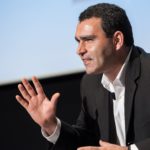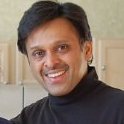When I first met Dan Marks in 2011 during his days as CMO at First Tennessee Bank, he blew me away with a model his team had built that accurately predicted the impact of an increase or decrease in ad spending. This was a particularly useful model as the bank like most businesses at the time was still in recession retrenchment mode and Dan needed to defend his budget. This conversation led me to believe that Dan was the poster child for CMOs that believed in the science of marketing and explains why I featured him in my book under the element, Metrics.
Five years later, Dan is now Chief Marketing Officer of Hancock and Whitney Bank and his winning The CMO Club President’s Circle award occasioned another interview. And while Dan is still a big believer in the science of marketing, I couldn’t help but notice a lot more interest on his part in the art of connecting with prospects and customers on an emotional level. This shift, if indeed it is one, means our conversation below is a perfect primer for marketers looking to take a more balanced approach, one that emphasizes purpose, culture and customer centricity as much as marketing technology, testing and measurement. Amen to that.
Drew: What’s one way that you apply renegade thinking?
Dan: I believe that a great CMO needs to embrace both the art and the science of marketing and that might be a bit radical with all of the focus on either the science or the art today.
Drew: How do you make sure there’s a balance?
Dan: The critical part to a balance is to remember that we are ultimately serving people. People respond to purpose. Whether or not that’s b2b or b2c or our associates, we all have human needs and emotions and desires and thoughts so focusing on what we deliver, sell, and develop resonates with people is the art and emotion part. Science can be a powerful tool to make sure that what were doing gets results and helps us achieve and continuously improve. Just doing the science without starting with the purpose is a recipe for failure. Only stopping at the purpose and not getting to the science can also leave us falling short.
Drew: Where have you found inspiration in these other categories, and what were the results?
Dan: Banking has a foundation of embracing technology. There are a number of things from a technology perspective. Recently, we’ve looked at how Apple does such a beautiful job of showing and creating excitement about what they do. There are tangible parts of what we do that are inspired by showing, not telling, in an emotional way. More recently, we were inspired by the fact that really compelling brands do a nice job wrapping bigger story around their product and services. when it comes to merchandising design, we didn’t just put together a brochure, we actually created a catalog which wraps those products with the bigger story and it’s had great reception and helped launch some new products in a compelling way.
Drew: What’s the bigger story for Hancock and Whitney?
Dan: Part of our story is that from Hancock and Whitney’s founding, the bank was chartered to help create opportunities for the communities and the clients that we serve. We look at everything through the mission of how are we helping people achieve their goals and dreams? Money is certainly an important mechanism for that but there’s a bigger purpose and its beyond the transaction. When we launched these products we wanted to make sure that we were focused on the client and what we’re doing for them, how we’re helping them run their business better. Not necessarily just the features and benefits.
Drew: What’s your proudest accomplishment as a marketer at Hancock and Whitney?
Dan: Seeing the team elevated and accomplishing great things. We just wrapped up 2016 and our financial performance, our stock price was up very nicely, reflects the underlying business fundamentals. To pull that off, it really was having a team that’s coming together. Seeing the team come together and raise their game was so far my proudest accomplishment. That gives me great confidence that we can continue to put up even more remarkable accomplishments in the future.
Drew: What was your focus from a marketing standpoint? Did you launch a new campaign, continue a new one, in terms of overall brand?
Dan: We doubled down where digital is going. We went through a selection process, identified a new marketing automation platform, which is a stack of tools that work together. We assembled this stack, and that created capabilities. For example, last year we were significantly more productive per dollar spent in terms of revenue generation than we were the year before. The specific number is confidentially but it was in the double digits more productive.
Drew: How do you do that?
Dan: Team, tools, and processes. How are we focusing on our best opportunities, what’s the purpose, what are we trying to accomplish? Having the right toolset is important. The day is gone where you’re relying on an agency or a yellow pad. Having a fully integrated marketing automation platform is key. We run our website on it, we do our social publishing through it, email, host landing pages that connect offline, we do events through it. It’s really the centerpiece to stitch that cohesive message together. And to learn from it- what is resonating, what’s getting the engagement, what’s creating leads.
Drew: How did you end up staffing this? Did you find that you needed more people to manage the stack?
Dan: We did, not many though. We’re big enough for some resources with an overall company size of 4,000 associates. We’ve got some ability to make meaningful decisions but execute them very quickly. We couldn’t afford the biggest, most full-featured engine that needs a gigantic crew. We picked a marketing automation engine that we thought positioned us really well to be nimble and have a lot of ease of us, but also not require a ton of staff. You need that more analytical, operational mindset but even there, the flavor that we have is much more “hey, we’re gonna use the tool for the operational parts” so we wanted one that was very easy to use. A related example is that we said “let’s prioritize what we can do with the tool. Sure we can do 100 things but is having an absolute perfect way to make something look we need?” If we can get pretty close with some out of the box capabilities, we’ll take pretty close and shipping twice as fast. We went through a burn-in time period where we had to reject some work from one particular agency that was still thinking in the old mindset.
Drew: How do you make sure that you have the right metrics, that you’re not optimizing based on one metric that you see?
Dan: Cost per acquisition or cost per whatever is a fairly dated metric. That’s an ingredient but if you stop there, you’ll miss what the actual value we’re generating is. Focusing on the revenue generated per dollar spent and defining that revenue as a lifetime revenue, we’re fortunate to be in an annuity-type business and by that I mean when we sell something it generates revenue over time, not just up front. We’re selling an ongoing relationship. Understanding the life of the accounts we sell and how that varies by segment is critical To understand the true discounted revenue impact compared to the dollar spent.
Drew: Do you have attribution modeling? In other words, can you say “search helped and the video helped and this helped” and somehow recognize the various contributors to that revenue?
Dan: We have an attribution model, but that’s something we can get better at. That’s where tools can come into play. The days of doing a traditional metric model are gone. I think a lot of brands realize that the potential from that kind of activity can’t be operationalized. When we look at further expanding our attribution, we’re focusing on leveraging very nimble tools that help us understand that quickly. We might give up some perceived statistical rigor but if I can get an 80% answer next week, that’s a lot better than a 95% answer 6 months from now.
Drew: What was the biggest hurdle to making all of this come to fruition?
Dan: The hurdle was just not enough hours in the day to do it all. Fortunately, there’s a lot of organizational and support from executives to take a different approach and up our game. We had to prove it so that there were incremental steps. It wasn’t go off and build the uber-platform for a year and then come back and get started. From the time I started at the company to the time we were running a campaign with the new platform was about 6 months and then we launched the new website the quarter after that. It was essentially changing out the tires while the bus is still rolling down the road.
Drew: What were the biggest lessons learned along the way?
Dan: One is that it starts with the client. What are we after for the client? Once you get past that, to your point about organizational hurdles, it’s critical. If you’re embarking on a marketing transformation and you don’t have 100% buy-in, that’s a good place to start with the credibility of the metrics. That’s where the science comes in a lot. You can’t start with perfection so start with a piece and work over time. Iterative and fact based is another lesson learned. We just don’t have time to spend on massive transformations that aren’t going to do anything for two years.

 It was one of those rare Los Angeles days — smog free, blue skies and the air was crisp. A perfect set up for what I hoped would be a perfect pitch. We were sitting in a diner right across the street from the bank headquarters in Pasadena and we were the opposite of stressed out. Like well-prepared boxers, we were ready, really ready. We were confident in our strategic sharpness and that we had the big idea. We even had most of the critical tactical details worked out to deliver a successful launch campaign. So when we walked over to the bank about 15 minutes before the appointed hour, witnesses might have seen a slight swagger in our step. Little did we know that our swagger was about to be shattered.
It was one of those rare Los Angeles days — smog free, blue skies and the air was crisp. A perfect set up for what I hoped would be a perfect pitch. We were sitting in a diner right across the street from the bank headquarters in Pasadena and we were the opposite of stressed out. Like well-prepared boxers, we were ready, really ready. We were confident in our strategic sharpness and that we had the big idea. We even had most of the critical tactical details worked out to deliver a successful launch campaign. So when we walked over to the bank about 15 minutes before the appointed hour, witnesses might have seen a slight swagger in our step. Little did we know that our swagger was about to be shattered.